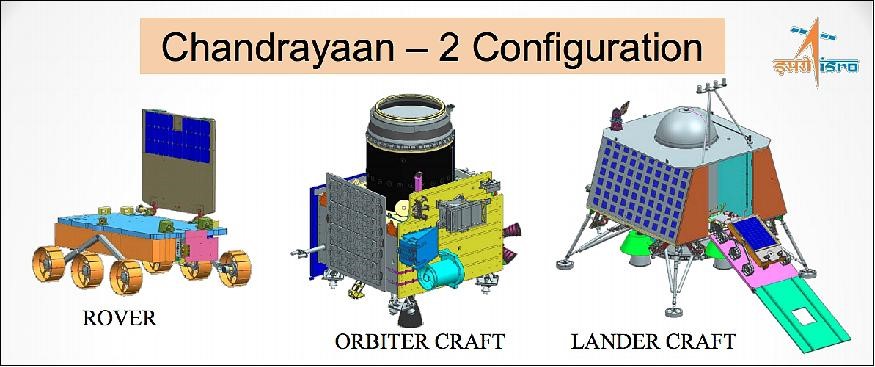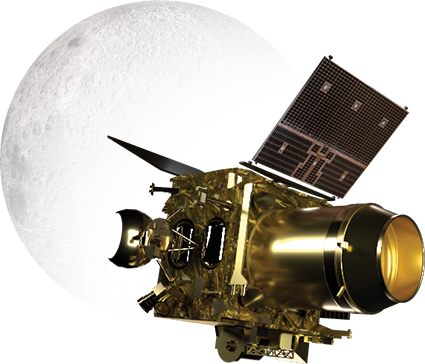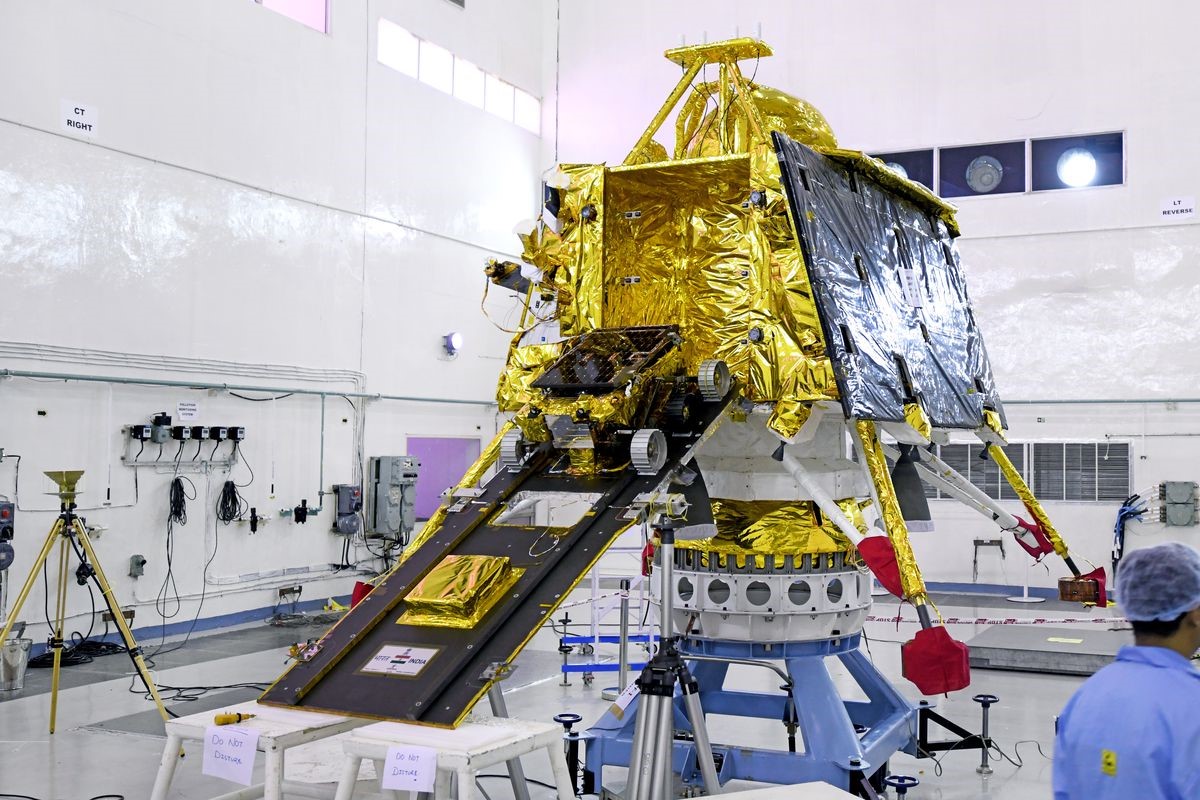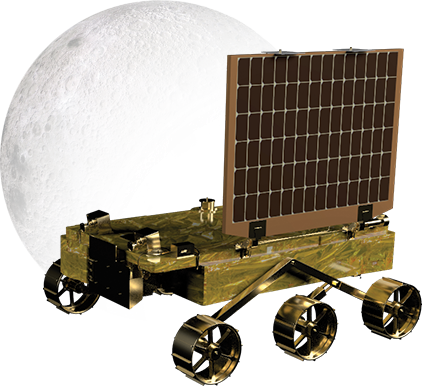
CHANDRAYAAN 2
CHANDRAYAAN 2
A BRIEF INTRODUCTION
Chandrayaan -2 is India’s second lunar mission to the Moon. It will make India the first country in the world to explore the Moon's south polar region. Chandrayaan -2 has been developed by India’s space agency Indian Space Research Organisation (ISRO) and was launched on 22 July 2019 at 2:43 pm from Satish Dhawan Space Center at Shri Harikota in Andhra Pradesh in a GSLV Mk III vehicle or BahuBalli rocket. It was launched into its planned orbit with a perigee (nearest point to Earth) of 169.7 km and an apogee (farthest point to Earth) of 45475 Km. GSLV Mk III is a three-stage launch vehicle developed by ISRO. The vehicle has two solid strap-ons, a core liquid booster and a cryogenic upper stage. It is designed to carry 4 ton class of satellites into Geosynchronous Transfer Orbit (GTO) or about 10 tons to Low Earth Orbit (LEO). The mission was originally scheduled to be launched on 15 July 2019 but was called off due to a technical glitch. It is a completely indigenous mission weighing 3,850 kg comprising of a lunar orbiter, a lander named Vikram, and a lunar rover named Pragyan. The Rover Pragyan is housed inside Vikram lander.
It is for the first time that a project is being spearheaded by women. Ritu Karidhal was the Mission Director of Chandrayaan-2 and Muthayya Vanitha was the Project Director, Chandrayaan-2.
OBJECTIVES OF CHANDRAYAAN 2
Chandrayaan 2 aims to reach the South pole of moon, a feat that has been never achieved by any country in the world. The lunar South Pole remains in shadow for a much larger time than that the North Pole. There is a possibility of the presence of water in permanently shadowed areas around it. In addition, South Pole region has craters that are cold traps and contain a fossil record of the early Solar System. Chandrayaan-2 will attempt to soft land the lander -Vikram and rover- Pragyan in a high plain between two craters, Manzinus C and Simpelius N, at a latitude of about 70° south.
The moon is the closest celestial body that can be studied to decipher the origins of the universe. These discoveries will be helpful to India and humanity as a whole.
DECIPHERING THE TECHNICAL COMPONENTS OF CHANDRAYAN-2
Chandrayaan 2’s total cost is Rs 978 crore which includes Rs 603 crore mission cost and Rs 375 crore for its launch-the cost of GSLV MK III.

-
LAUNCHER
The GSLV Mk-III carried Chandrayaan 2 to its designated orbit. This three-stage vehicle is India's most powerful launcher to date, and is capable of launching 4-ton class of satellites to the Geosynchronous Transfer Orbit (GTO). It includes S200 solid rocket boosters, L110 liquid stage and C25 upper stage.
-
ORBITER
The orbiter will observe the lunar surface and relay communication between Earth and Chandrayaan 2's Lander- Vikram. The mission life of the Orbiter is one year and it will be placed in a 100X100 km lunar polar orbit. The approximate launch mass was 2,379 kg. The orbiter's structure was manufactured by Hindustan Aeronautics Limited and delivered to ISRO Satellite Centre.

-
LANDER
The Lander of Chandrayaan 2 is named Vikram after Dr Vikram A Sarabhai, the Father of the Indian Space Programme. It is designed to function for one lunar day, which is equivalent to about 14 Earth days. It will enable the delivery of the Pragyan Rover to the lunar surface while conducting a few experiments of its own. The rover will roll out once the lander has successfully landed at the desired spot. It also consists of several instruments or payloads that will be constantly carrying out experiments throughout its mission time. The payloads include a Langmuir probe, thermal probe and a seismometer.
Vikram has the capability to communicate with the Orbiter and Rover. The lander weighs 1,471 kg including the Pragyan Rover (27 kg) inside and it’s capable of generating about 650 W of electricity.
It is expected to make a soft landing on the lunar surface in order to prevent any kind of damage to sensitive instruments onboard. This will make India the fourth country in the world to have a safe landing on moon’s surface.

-
ROVER-PRAGYAN
The rover of Chandrayaan 2 is a 6-wheeled robotic vehicle named Pragyan, which is a Sanskrit word meaning 'wisdom'. It is able to travel up to 500 m (0.5 km) at a speed of 1 centimetre per second and it is powered by solar energy. It is capable of only communicating with Chandrayaan 2's Lander.
The total weight of Pragyan Rover is 27 kg and it has an electric power generation capacity of 50 W. Pragyan Rover Mission Payloads are Alpha Particle X-ray Spectrometer (APXS) and Laser Induced Breakdown Spectroscope (LIBS).
The main objective of APXS is to determine the elemental composition of the surface of moon near the landing site of rover.
On the other hand, LIBS helps in identification and determination of the abundance of elements near the landing site on the lunar surface.

TIMELINE OF CHANDRAYAAN- 2
- November 12, 2007- Representatives of the Russian Federal Space Agency (Roscosmos) and ISRO sign an agreement for the two agencies to work together on the Chandrayaan-2 project.
- September 18, 2008- Government approves the mission to the moon in a meeting chaired by PM Manmohan Singh.
- August 2009- Isro and Roscosmos complete the design of Chandrayaan-2 and it is reviewed by India and Russia.
- 2016- The mission is repeatedly postponed and re-scheduled because of Russia's delay in developing the lander on time. Eventually, Roscosmos withdraws from the agreement. India decides to develop the lunar mission independently.
- July 15, 2019- Chandrayaan-2 was scheduled to be launched, but it was put off due to technical snag.
- July 22, 2019- Candrayaan-2 was launched from the second launchpad at Sriharikota’s Satish Dhawan Space Centre (SDSC) at 2: 44 pm.
- August 20, 2019- Chandrayaan 2 successfully entered the lunar orbit of the Moon.
- August 21, 2019- Chandrayaan-2 on sent its first Moon image captured by Vikram Lander at a height of about 2650 km from the lunar surface.
- September 7, 2019- Chandrayaan-2 is expected to make a soft landing on the moon’s surface.
QUICK FACTS ABOUT CHANDRAYAAN-2
- First space mission to conduct a soft landing on the Moon's South Polar Region
- First Indian expedition to attempt a soft landing on the lunar surface with home-grown technology
- First Indian mission to explore the lunar terrain with home-grown technology
- Moreover, India will become the fourth country in the world to soft-land on the lunar surface, a feat previously accomplished by only three other countries - the US, Russia, and China.
- The mission life of Chandrayaan-2’s Orbiter will be one year whereas the mission life of lander (Vikram) and rover (Pragyan) will be one Lunar day which is equal to fourteen earth days.
INDIA’S JOURNEY FROM CHANDRAYAAN 1 TO CHANDRAYAAN 2
The journey of India’s Chandrayaan missions started in 2000 with the announcement of the Prime Minister Atal Biari Vajpayee. Chandrayaan-1 was India's first mission to moon, which was launched by Polar Satellite launch Vehicle, PSLV-C11 on October 22, 2008, from Sriharikota. Chandrayaan-1 made more than 3,400 orbits around the moon. It was operational for 312 days till August 29, 2009. The lift-off mass of Chandrayaan-1 was 1380 kg.
The Chandrayaan-1 discovered traces of water on the moon-a path-breaking discovery in the world of space science. Chandrayaan-1 also discovered water ice in the North polar region of the Moon. It also detected Magnesium, Aluminium and Silicon on the lunar surface. Global imaging of the moon is another achievement of this mission.
There were eleven scientific instruments onboard Chandrayaan-1 spacecraft. Five of them were Indian and other six were from ESA (3), NASA (2) and Bulgarian Academy of Sciences (1) selected through ISRO Announcement of Opportunity (AO). Two of the ESA instruments had Indian collaboration.
The complete world will be witnessing the historical moment of Chandrayaan’s 2 soft landing on 7 September 2019 registering India on the world’s map as the next space powerhouse.
Also with the successful launch of Chandrayaan 2, India has definitely carved a niche for itself on the global map with ISRO being one of the strongest pillars of India’s development. At this critical junction, it is of utmost importance that India promotes research, development and innovation in the country. These will lay the foundation stone of India’s journey to realising the dream of becoming a $5 trillion economy by 2025.
Jai Hind!













Pooja Goyal
Thanks a lot for supporting us in our study.